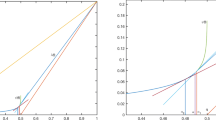Abstract
A finite volume element method for solving the two-dimensional scalar convection–diffusion equation is presented. The finite volume method is used to derive the discretized equations for the convection–diffusion equation, while the finite element technique is applied to determine the gradient quantities at cell faces. Second-order accuracy in both space and time are achieved by applying the Taylor’s series expansion along the local characteristic lines. An adaptive meshing technique is incorporated to further improve the computed solution accuracy. Four numerical test cases are presented to evaluate the performance of the combined method. These test cases are the pure-convection and convection-dominated problems.
Similar content being viewed by others
References
Wang H., Liu J.: Development of CFL-free explicit schemes for multidimensional advection–reaction equations. SIAM J. Sci. Comput. 23(4), 1418–1438 (2001)
Zienkiewicz O.C., Taylor R.L.: The Finite Element Method Volume 3: Fluid Dynamics. 5th edn. Butterworth-Heinemann, London (2000)
Malatip A., Wansophark N., Dechaumphai P.: Combined streamline upwind Petrov Galerkin method and segregated finite element algorithm for conjugated heat transfer problems. J. Mech. Sci. Technol. 20(10), 1741–1752 (2009)
Leveque R.L.: Finite Volume Methods for Hyperbolic Problems, 3rd edn. Cambridge University Press, Cambridge (2005)
Zienkiewicz O.C., Codina R.: A general algorithm for compressible and incompressible flow—part I. The split, characteristic-based scheme. Int. J. Numer. Methods Fluids 20, 869–885 (1995)
Codina R.: Comparison of some finite element methods for solving the diffusion–convection–reaction equation. Comput. Methods Appl. Mech. Eng. 156, 185–210 (1998)
Jasak H., Weller H.G., Gosman A.D.: High resolution NVD differencing scheme for arbitrarily unstructured meshes. Int. J. Numer. Methods Fluids 31, 431–449 (1991)
Kruganov A., Tadmor E.: New high-resolution central schemes for nonlinear conservation laws and convection–diffusion equations. J. Comput. Phys. 160, 241–282 (2000)
Lamine S., Edwards M.G.: High-resolution convection schemes for flow in porous media on highly distorted unstructured grids. Int. J. Numer. Methods Eng. 76, 1139–1158 (2008)
Phongthanapanich S., Dechaumphai P.: A characteristic-based finite volume element method for convection–diffusion–reaction equation. Trans. Can. Soc. Mech. Eng. 32, 549–559 (2008)
Phongthanapanich S., Dechaumphai P.: Combined finite volume and finite element method for convection–diffusion–reaction equation. J. Mech. Sci. Technol. 23, 790–801 (2009)
Phongthanapanich, S., Dechaumphai, P.: Adaptive delaunay triangulationwith multidimensional dissipation scheme for high-speed compressible flow analysis. Appl.Math.Mech. 26, 1341–1356 (English Edition) (2005)
Phongthanapanich S., Dechaumphai P.: Mixed entropy fix method for Roe’s flux-difference splitting scheme with automatic mesh adaptation. Trans. Can. Soc. Mech. Eng. 28, 531–549 (2004)
Boonmarlert P., Phongthanapanich S., Dechaumphai P.: Combined characteristic-based split algorithm and mesh adaptation technique for high-speed compressible flow analysis. Indian J. Eng. Mater. Sci. 12, 376–388 (2005)
Wansophark N., Dechaumphai P.: Combined adaptive meshing technique and segregated finite element algorithm for analysis of free and forced convection heat transfer. Finite Elem. Anal. Des. 40, 645–663 (2004)
Phongthanapanich S., Traivivatana S., Boonmaruth P., Dechaumphai P.: Nodeless variable finite element method for heat transfer analysis by means of flux-based formulation and mesh adaptation. Acta Mech. Sin. 22, 138–147 (2006)
Phongthanapanich S., Dechaumphai P.: Adaptive nodeless variable finite elements with flux-based formulation for thermal-structural analysis. Acta Mech. Sin. 24, 181–188 (2008)
Barth T., Ohlberger M.: Finite Volume Methods: Foundation and Analysis. Encyclopedia of Computational Mechanics Volume 1: Fundamentals. Wiley, Hoboken (2004)
Author information
Authors and Affiliations
Corresponding author
About this article
Cite this article
Theeraek, P., Phongthanapanich, S. & Dechaumphai, P. Combined adaptive meshing technique and finite volume element method for solving convection–diffusion equation. Japan J. Indust. Appl. Math. 30, 185–202 (2013). https://doi.org/10.1007/s13160-012-0095-8
Received:
Revised:
Published:
Issue Date:
DOI: https://doi.org/10.1007/s13160-012-0095-8




